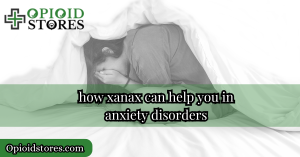How Xanax Can Help you in Anxiety Disorders
Anxiety disorder is one of the most common things in youngsters. We are dealing with a lifestyle that only gives us stress. no matter how Xanax can help. how hard we try, we are the generation with high expectations and less effort. All these things make us anxious. Living with anxiety and dissatisfaction has become a part of our life.
However, it is entirely normal if you are eager about a few things related to your life or work, but if this becomes a habit or if it starts triggering your mind every time, then this is an alarming sign. Xanax is one of the best working and highly prescribed medicines for those suffering from anxiety disorder. Let’s know more about it.
Introduction of How Xanax Can Help with Anxiety Disorder
Before knowing about anxiety disorder, let us know a few things about anxiety and panic attacks. This will help you understand the topic well and easily differentiate between things.
What is Anxiety?
Anxiety is a natural emotion, and anyone can feel it anytime. It can also cause some physical symptoms like sweating and shaking. It is so clear that anxiety can affect your daily life, but it can be improved with treatment.
How Xanax Can Help Panic Attack
A panic attack is a sudden attack of extreme fear that can occur without a specific trigger. These attacks typically last between 10 and 20 minutes. During a panic attack, individuals may experience rapid heart rate, sweating, shaking, shortness of breath, and a sense of impending doom.
How Xanax Can Help Anxiety Disorder
Feeling anxious is normal, and everyone can experience it at some stage, but people suffering from anxiety disorders generally experience fear and worry, which are both severe and extreme. The feeling is generally accompanied by physical tension and other behavioral as well as because of some cognitive symptoms. The symptoms of anxiety disorder are hard to control, and it causes significant distress. If left untreated, it will last for a longer time. Anxiety disorder mainly interferes with daily life activities and can impair a person’s social life, family, and other work, including school.
Approximately 4% of the global population is currently living with an anxiety disorder, totaling 301 million people worldwide in 2019. This makes anxiety disorders the most prevalent mental health condition. Instead of the availability of adequate treatments, only about a quarter of those in need receive any form of therapy. How Xanax Can Help Barriers to Care include lack of awareness about treatability, insufficient investment in mental health services, shortage of trained healthcare providers, and social stigma.
Anxiety and anxiety disorder
Anxiety is a multifaceted reaction to actual or perceived dangers. It may contain cognitive, physical, and behavioral alterations. When there is a natural or perceived threat, the body releases adrenaline, a hormone, and chemical messenger in the brain, leading to anxiety reactions as part of the fight-or-flight response. This reaction can occur in challenging social scenarios or during significant events or choices.
The physical signs include nausea and increased blood pressure. The responses are beyond anxiety, termed an anxiety disorder.
What is Xanax 1 mg?
Xanax 1 mg comes under the drug class Benzodiazepines, which is used for the cure of anxiety disorders and anxiety which is caused because of depression. In some cases, Xanax is used for the cure of panic disorders, either with or without the fear of locations and situations that may induce panic, embarrassment, or helplessness.
Xanax 1 mg is highly suggested as one of the best medicines for the cure of anxiety disorder. Most of the physicians prescribe it because of its effectiveness and best action.
Use of Xanax 1 mg
Xanax 1 mg has been approved by the FDA to be used in treating panic and anxiety disorders, like generalized anxiety disorder and panic disorder with or without agoraphobia (a fear of situations where help may not be available or escape may not be possible).
Xanax 1 mg is often prescribed by physicians to provide short-term relief from signs of anxiety. It is also effective in treating panic attacks, which are distinguished by intense duration of fear.
Additionally, Xanax 1 mg may be used to alleviate symptoms of premenstrual syndrome. Other benzodiazepines are utilized in the treatment of mental health disorders like social anxiety disorder, sleep issues, spasticity, and epilepsy.
How does Xanax 1 mg work to treat anxiety disorders?
Xanax 1 mg works by enhancing the effects of gamma-aminobutyric acid (GABA). It is a neurotransmitter present in the brain. GABA inhibits neuronal activity, producing a calming effect. Xanax 1 mg binds to GABA receptors, amplifying its inhibitory action, which helps to reduce anxiety, nervousness, and tension. The effectiveness of benzodiazepine provides quick relief from acute anxiety symptoms.
You must know that Xanax 1 mg is generally prescribed for short-term use because of its potential misuse, dependence, tolerance, and withdrawal symptoms. You must follow your physician’s advice to avoid any unwanted situations and remember that prolonged use of Xanax 1 mg can lead to decreased efficacy, and you need to increase the dose for effectiveness.
How long does Xanax 1 mg take to stop anxiety?
Xanax 1 mg is known for its rapid action in providing quick relief from symptoms of anxiety and panic disorder. Typically, the effects of the medication can be felt within 30-60 minutes, reaching peak concentration in the body 1-2 hours after ingestion. Due to its short half-life, the effects of Xanax 1 mg diminish quickly, often requiring multiple daily doses based on individual stress levels and medical advice.
The typical dosage of Xanax 1 mg to alleviate anxiety is 0.25 to 0.5 mg, taken three times daily. This dosage can be raised every 3-4 days, with the maximum dosage being 4 mg daily. For panic disorders, the average daily dosage of Xanax i1 mg is 5-6 mg, although some patients may need up to 10 mg daily.
Can I take Xanax 1 mg every day for anxiety?
Xanax 1 mg is intended for short-term relief of anxiety and panic attacks, so other medications may be prescribed for ongoing symptom management. It is important to take this medication at the lowest effective dosage. Your healthcare provider will regularly evaluate your condition and may consider reducing your maintenance dosage once your symptoms improve with less medication.
It is crucial to follow your physician’s prescription for Xanax 1 mg precisely. Prolonged use of this medication can lead to dependence. Abruptly discontinuing Xanax can result in unpleasant and possibly dangerous withdrawal symptoms.
Please adhere to your healthcare expert’s recommended dosage instructions. Do not raise the dosage, frequency of dosing, or length of treatment without consulting your healthcare provider for approval.
Risk factors with Xanax 1 mg.
Side effects: In some cases, Xanax 1 mg can lead to side effects like drowsiness, headache, dizziness, headache, irritability, fatigue, memory problems, problems in concentration, frequent changes in appetite, nausea, weight changes, constipation, urinary difficulties, sex drive, and joint pain.
Serious side effects of Xanax 1 mg may include:
- Difficulty breathing or shallow breaths.
- Feeling dizzy, as if you might faint.
- Experiencing a seizure.
- Having hallucinations or engaging in risky behavior.
- Feeling more energetic and needing less sleep.
- Having racing thoughts, feeling agitated, or being overly talkative.
- Experiencing double vision.
- Developing jaundice, which is characterized by yellowing of the skin or eyes.
- Potential for misuse: We are well aware of the use of Xanax 1 mg; it is a habit-forming medicine if misused. Xanax 1 mg can lead to psychological and physical dependence. Misuse, abuse, and addiction can increase the chances of overdose and other fatal effects. You must inform your physician if you have a history of drug abuse. Depending on the situation, they will provide the best treatment for you.
- Withdrawal symptoms: Ceasing Xanax 1 mg abruptly after long-term use can result in withdrawal symptoms. These may include alterations in behavior, difficulties with sleep, hallucinations, and seizures. Your healthcare expert will provide direction on gradually reducing the dosage.
- Sedative effects: Xanax 1 mg may lead to drowsiness and dizziness, impacting your focus and concentration. This could raise the likelihood of falls, injuries, and accidents. It is advisable to refrain from driving or engaging in risky activities until you understand its effects on you. Additionally, it is best to avoid alcohol while taking Xanax 1 mg, as it can exacerbate these side effects.
- Respiratory depression: Xanax 1 mg has the potential to slow down your breathing, especially if you are also using other central nervous system depressants like opioid pain medications. If you experience slowed or shallow breathing or extreme drowsiness after taking Xanax 1 mg, seek medical assistance immediately.
Conclusion
We have discussed so much about anxiety disorder and some of the closely related terms. Anxiety can be because of any reason, and it can easily gone if you take good care of and change your lifestyle. However, there are some things different with anxiety disorder. In the case of anxiety disorder, the things last longer and always trigger you.
+One of the most trusted medicines that work so well for managing anxiety disorder is Xanax 1 mg. It works great and helps you a lot. You must remember that the medicine works wonders, but still, you have to use it as prescribed by your physician and never misuse the drug.


